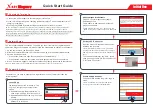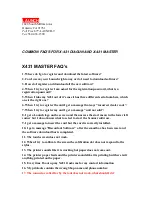
1676-002 en/2022-05
25/52
Operation
/5
5.7 Degassing sonication fluid
Sonication fluid that has been freshly filled or left in the ultrasonic
oscillating tank must be degassed before use. Degassing the soni-
cation fluid increases the effect of the ultrasound.
• Cover the ultrasonic oscillating tank with the lid if available.
• Switch the ultrasound on for degassing. The degassing time is:
– Volume of sonication fluid up to 10 litres:
10 minutes
– Volume of sonication fluid over 10 litres:
30 minutes
Information
The ultrasound noise becomes quieter during degassing. This
means that the ultrasonic effect is increasing.
5.8 Adding goods to be treated
To achieve good results, observe the following information when
inserting goods to be treated:
• Each time before sonication, check whether the sonication fluid
is contaminated. If there is visible contamination, replace the
sonication fluid.
• The sonication fluid must be degassed. See chapter
• The sonication fluid must be preheated to the required working
temperature before you add objects.
• Use suitable accessories, e.g. a basket. Do not place any objects
directly on the bottom of the ultrasonic oscillating tank. Use a
studded silicone mat for sensitive objects. See chapter
.
• Insert objects so they are distributed. Do not stack them. Sensi-
tive objects may not touch other objects.
• The ultrasound must be switched off while objects are being
inserted.
• Check the filling level. The goods to be treated must be com-
pletely submerged in the fluid. Inset beakers for indirect sonica-
tion need to be submerged at least 2 cm in the sonication fluid.
• Remove air bubbles from cavities. Rotate the objects accord-
ingly. Remove air bubbles under inset beakers. The ultrasound
















































